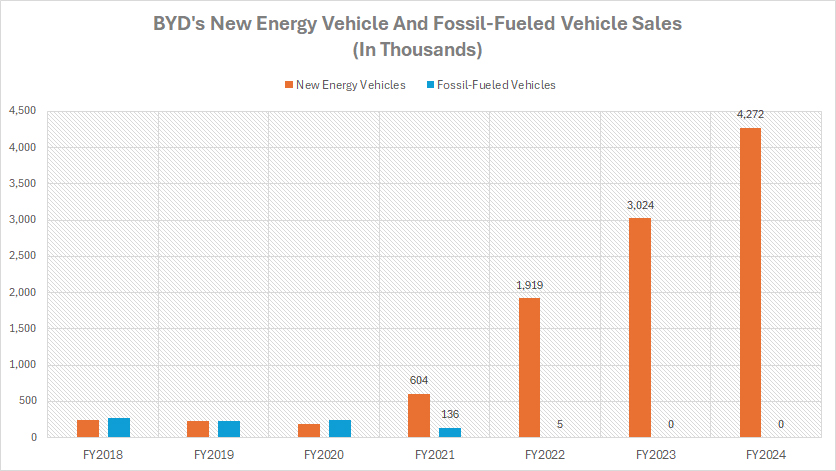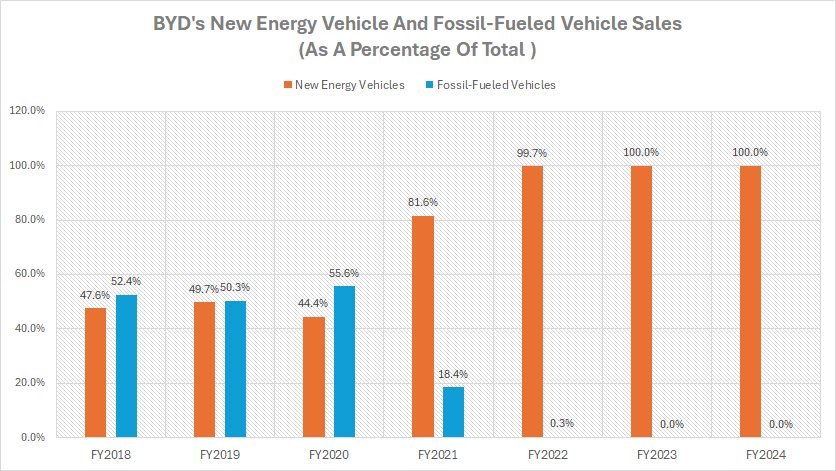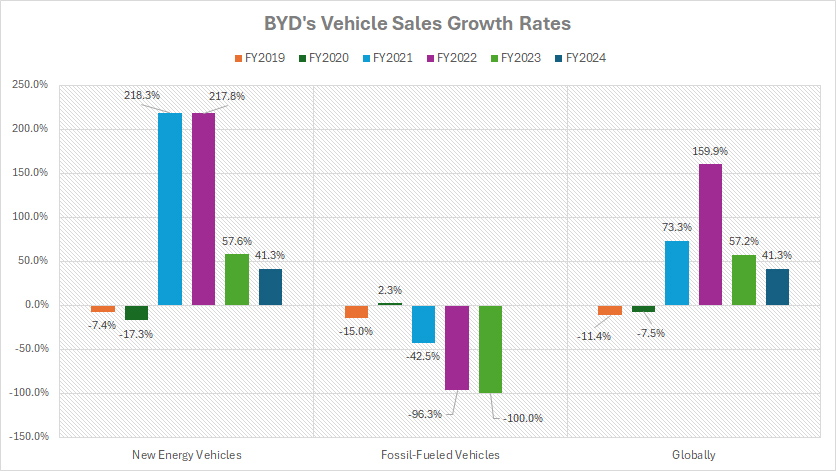
Green tech. Pixabay image.
BYD, which stands for “Build Your Dreams,” is a Chinese multinational company headquartered in Shenzhen, Guangdong. It was founded in 1995 and has grown to become a global leader in several key industries, particularly in renewable energy solutions and electric vehicles (EVs).
BYD has expanded its operations globally, with a presence in over 50 countries. This article covers BYD’s global vehicle sales and the sales breakdown by category.
Let’s get started!
For other key statistics of BYD, you may find more resources on these pages:
Sales
Revenue
Profit Margin
- BYD gross margin, vehicle margin, and profit per car,
- BYD vs Tesla: vehicle profit and margin analysis
R&D Budget
- BYD vs Tesla: R&D spending
Please use the table of contents to navigate this page.
Table Of Contents
Definitions And Overview
O2. What is driving the significant growth in BYD’s global vehicle sales?
Consolidated Sales
Sales By Category
B1. New Energy Vehicle And Fossil-Fueled Vehicle Sales
B2. Percentage Of New Energy Vehicle And Fossil-Fueled Vehicle Sales To Total Volume
Growth Rates
C1. Growth Rates Of Global Vehicle, New Energy Vehicle, And Fossil-Fueled Vehicle Sales
Conclusion And Reference
S1. Conclusion
S2. References and Credits
S3. Disclosure
Definitions
To help readers understand the content better, the following terms and glossaries have been provided.
New Energy Vehicle (NEV): BYD’s New Energy Vehicles (NEVs) refer to a range of vehicles powered by alternatives to fossil fuels, primarily electricity.
NEVs encompass various types of electric vehicles, including Battery Electric Vehicles (BEVs) and Plug-in Hybrid Electric Vehicles (PHEVs).
BEVs are fully electric vehicles powered solely by batteries, which are charged externally. PHEVs combine an internal combustion engine with an electric motor, allowing them to run on electricity until the battery is depleted, at which point the internal combustion engine takes over.
BYD, as a leading NEV manufacturer, has developed advanced technologies to enhance the performance and efficiency of these vehicles.
What is driving the significant growth in BYD’s global vehicle sales?
Several factors are driving the significant growth in BYD’s global vehicle sales:
- Expansion into International Markets: BYD has strategically expanded its presence in various international markets, including Europe, North America, and Latin America. This global expansion has allowed the company to tap into new customer bases and increase its sales.
- Innovative and Diverse Product Lineup: BYD offers a wide range of new energy vehicles (NEVs), including battery electric vehicles (BEVs) and plug-in hybrid electric vehicles (PHEVs). The introduction of fresh, eye-catching models with impressive range and fast charging capabilities has attracted a broad audience.
- Technological Advancements: BYD is known for its technological innovations, such as the e-Platform 3.0 and the Blade Battery. These advancements enhance the performance, efficiency, safety, and smart features of their vehicles, making them more appealing to consumers.
- Competitive Pricing: BYD’s affordable pricing strategy has made electric vehicles accessible to a wider audience. By offering competitive prices, BYD has been able to attract cost-conscious consumers looking for sustainable transportation solutions.
- Government Support and Incentives: Government policies and incentives promoting the adoption of electric vehicles have also played a crucial role in BYD’s growth. Subsidies, tax breaks, and other incentives have encouraged consumers to choose NEVs over traditional internal combustion engine vehicles.
- Strong Sales Performance: BYD has achieved impressive sales figures, with record-breaking sales of over 500,000 NEVs in a single month. This strong sales performance has solidified BYD’s position as a leader in the new energy vehicle market.
These factors combined have contributed to BYD’s significant growth in global vehicle sales, positioning the company as a major player in the electric vehicle industry.
Global Vehicle Sales
byd-global-car-sales
(click image to expand)
At the end of fiscal year 2023, BYD’s global vehicle sales reached an impressive 3 million units, representing a remarkable 50% growth compared to the previous year.
This significant milestone underscores the company’s rapid expansion and increasing market presence. Building on this momentum, BYD delivered 4.3 million vehicles in fiscal year 2024, marking a substantial increase from the 3 million vehicles sold in 2023.
In the preceding years, BYD’s growth trajectory was also noteworthy. The company sold 1.9 million vehicles in 2021, a significant rise from the 740 thousand vehicles sold in 2020.
This rapid increase in sales reflects BYD’s successful adaptation to market demands and the growing popularity of its new energy vehicles (NEVs).
Looking further back, prior to 2020, BYD’s global vehicle sales were consistently under 500 thousand units annually. This relatively modest sales volume highlights the dramatic growth the company has achieved in recent years.
The surge in sales can be attributed to various factors, including BYD’s innovative product lineup, expansion into international markets, and the rising global demand for sustainable transportation solutions.
New Energy Vehicle And Fossil-Fueled Vehicle Sales
byd-sales-of-new-energy-vehicles-and-fossil-fueled-vehicles
(click image to expand)
BYD’s global vehicle sales are made up of two categories of vehicles: new energy vehicle and fossil-fueled vehicle. The definition of BYD’s new energy vehicle is available here: new energy vehicle.
Prior to 2020, BYD sold nearly an equal number of new energy and fossil-fueled vehicles. However, since 2020, new energy vehicle (NEV) sales have increasingly dominated BYD’s global deliveries, as depicted in the chart above.
By the end of fiscal year 2023, BYD’s NEV deliveries reached an impressive 3 million units, while the sales of fossil-fueled vehicles had completely dwindled to zero. This marked a significant milestone in BYD’s transition towards sustainable transportation.
This trend continued into fiscal year 2024, with BYD’s NEV deliveries increasing to 4.3 million units, up from 3 million in the previous year. Meanwhile, the sales of fossil-fueled vehicles remained at zero. This shift signifies BYD’s complete phasing out of fossil-fueled vehicles from its lineup since 2023.
The growth trajectory of BYD’s NEV sales is remarkable. In fiscal year 2022, the company sold 1.9 million NEVs, a substantial increase from the 600 thousand units delivered in 2021. This represents a growth rate of over 200% between 2021 and 2022. The momentum continued, with NEV sales growing by over 50% in 2023.
On the other hand, BYD’s sales of fossil-fueled vehicles saw a sharp decline. In 2021, the company sold 136 thousand fossil-fueled vehicles, but this number plummeted to just 5 thousand units in 2022. By 2023, the sales of fossil-fueled vehicles had ceased entirely.
This dramatic shift highlights BYD’s strategic focus on new energy vehicles and its commitment to sustainable transportation. The company’s ability to rapidly scale its NEV production and completely phase out fossil-fueled vehicles within a few years is a testament to its innovative approach and adaptability in the evolving automotive market.
As BYD continues to expand its NEV offerings and explore new markets, it is well-positioned to maintain its leadership in the global transition towards greener, more sustainable transportation solutions.
Percentage Of New Energy Vehicle And Fossil-Fueled Vehicle Sales To Total Volume
byd-sales-percentage-of-new-energy-vehicles-and-fossil-fueled-vehicles
(click image to expand)
BYD’s global vehicle sales are made up of two categories of vehicles: new energy vehicle and fossil-fueled vehicle. The definition of BYD’s new energy vehicle is available here: new energy vehicle.
From the perspective of percentage, BYD’s new energy vehicles (NEVs) made up 100% of the company’s total sales volume in 2023, as fossil-fueled vehicles were completely phased out during this period. This marked a significant milestone in BYD’s transition towards sustainable transportation solutions.
This trend continued in 2024, with NEVs once again accounting for 100% of BYD’s total vehicle sales. The complete shift from fossil-fueled vehicles to new energy vehicles highlights BYD’s commitment to sustainability and its leadership in the electric vehicle market.
In 2022, the sales percentages were 99.7% NEVs and just 0.3% fossil-fueled vehicles, with the latter dropping to a mere 5 thousand units. This dramatic decrease in fossil-fueled vehicle sales underscores the rapid shift in consumer demand towards environmentally friendly alternatives.
In fiscal year 2021, fossil-fueled vehicles still made up about 18% of BYD’s overall sales volume, while NEVs represented the remaining 82%. This significant reduction from previous years reflects the accelerating transition to NEVs.
Before 2021, BYD’s sales were evenly split between new energy and fossil-fueled vehicles, with each category contributing an equal percentage to the overall sales volume.
However, the company’s strategic focus on NEVs and the increasing global emphasis on sustainability have driven a rapid and decisive shift away from fossil-fueled vehicles.
Overall, BYD’s transition to 100% NEV sales from a balanced mix of NEVs and fossil-fueled vehicles before 2021 illustrates the company’s adaptability and forward-thinking approach.
This shift not only aligns with global sustainability goals but also positions BYD as a frontrunner in the new energy vehicle industry, paving the way for continued growth and innovation in the electric vehicle market.
Growth Rates Of Global Vehicle, New Energy Vehicle, And Fossil-Fueled Vehicle Sales
byd-growth-rates-of-vehicle-sales
(click image to expand)
BYD’s global vehicle sales are made up of two categories of vehicles: new energy vehicle and fossil-fueled vehicle. The definition of BYD’s new energy vehicle is available here: new energy vehicle.
From the perspective of sales growth, BYD’s global car sales experienced remarkable increases over recent years. In fiscal year 2024, the company’s sales grew by 41%, following a 57% growth in fiscal year 2023, and an astounding 160% growth in 2022.
On average, BYD’s global car sales have shown an impressive average annual growth rate of 86% between 2022 and 2024. This significant upward trajectory underscores the company’s strong market presence and successful strategies.
The driving force behind BYD’s vehicle sales growth has been the surge in new energy vehicle (NEV) sales, as depicted in the chart above. In 2024, BYD’s NEV sales grew by 41%, following a 58% growth in 2023, and a stunning 218% growth in 2022.
This consistent and rapid increase highlights the growing consumer demand for sustainable transportation solutions. On average, BYD’s NEV sales achieved a remarkable growth rate of 106% from 2022 to 2024, solidifying the company’s leadership in the electric vehicle market.
On the other hand, BYD’s sales of fossil-fueled vehicles have declined to zero by 2023, illustrating a complete phase-out of internal combustion engine (ICE) cars from the company’s lineup. This strategic shift aligns with global efforts to reduce carbon emissions and transition to cleaner energy sources.
In summary, BYD’s exceptional growth in global car sales, driven primarily by the surge in new energy vehicle sales, marks a significant transformation in the company’s strategy and market positioning.
Conclusion
In summary, one of the most significant insights is BYD’s complete transition from fossil-fueled vehicles to NEVs. Prior to 2020, BYD’s sales were nearly evenly split between NEVs and fossil-fueled vehicles.
However, by fiscal year 2023, NEVs accounted for 100% of the company’s total sales volume, with fossil-fueled vehicles being completely phased out.
This strategic shift reflects BYD’s commitment to sustainability and positions it as a frontrunner in the global transition to cleaner energy sources.
References and Credits
1. All sales figures presented were obtained and referenced from BYD’s monthly production and sales reports published on the company’s investor relations page: BYD Latest Announcement.
2. Pixabay images.
Disclosure
We may utilize the assistance of artificial intelligence (AI) tools to produce some of the text in this article. However, the data is directly obtained from original sources and meticulously cross-checked by our editors multiple times to ensure its accuracy and reliability.
If you find the information in this article helpful, please consider sharing it on social media. Additionally, providing a link back to this article from any website can help us create more content like this in the future.
Thank you for your support and engagement! Your involvement helps us continue to provide high-quality, reliable content.




